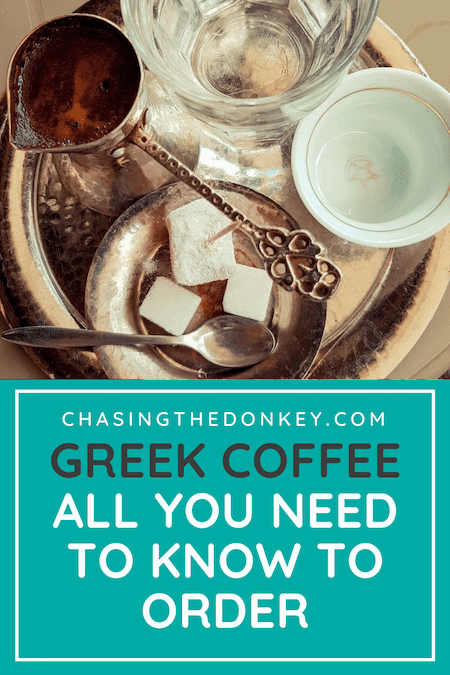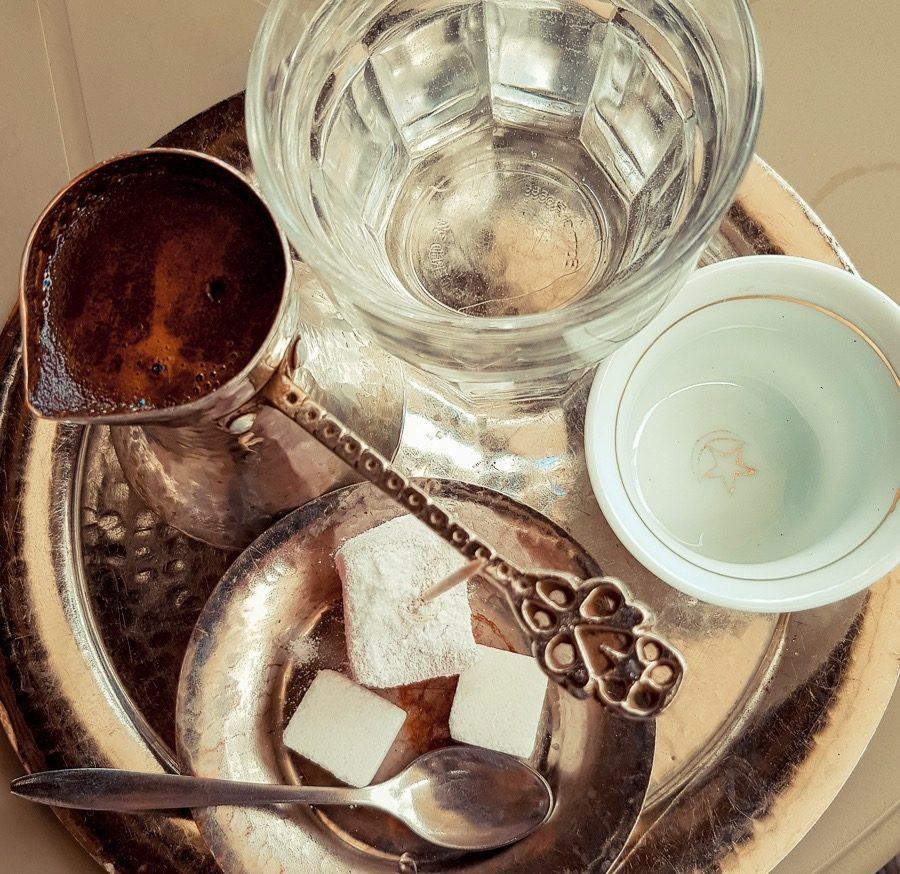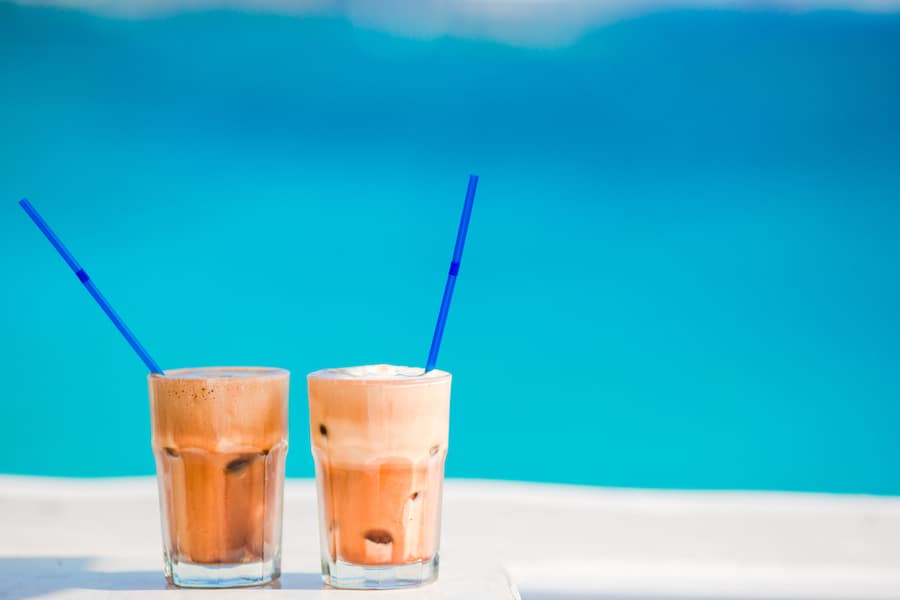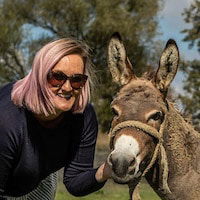Coffee and the rituals surrounding coffee are a key part of Greek popular culture. Here is all you need to know about ordering coffee in Greece from Thessaloniki to Santorini.
I have covered all the types of coffee in Greece, from the Ottoman Empire-inspired coffees that are thick and dark, delivered to you in small porcelain cups, to the type now popular in modern Greece that are made with cold water and ice cubes served in a tall glass.

Do you know all about the food and coffee culture in Greece? Coffee and the ritual surrounding coffee are a key part of Greek popular culture. A good coffee is key to a great day.
It has not so much to do with drinking coffee in itself as it has to do with meeting friends, enjoying conversation, and spending long hours together.
When someone in Greece invites you for a coffee, make your schedule flexible, at least for the next two to three hours!
Whether traveling to small villages or being kicked back in an Athens cafe, you will love your coffee breaks once you learn all there is to know about the perfect cup of coffee (or ten) in Greece.
Don’t worry if it is your first time trying to wrap your tongue around the Greek language – Greek people totally love it when you try to speak their language.
Skip Ahead To My Advice Here!
Ordering & Drinking Coffee In Greece – Coffee Culture In Greece

It’s not that hard to order coffee in Greece, but it depends on what you want to try.
First, deciding whether you’re in the mood for a hot cup of coffee or if you would enjoy a cold version of the black beverage instead is a good idea.
After your first sip of any cup of Greek coffee, you’ll soon know if you like it hot or cold, so do try both to decide.
The simplest way to put it at the bar or cafeteria would be “Ena cafe, parakalo,” which translates as “One coffee, please.”
Usually, the questions that follow would be whether you want it with sugar or not, and with how much sugar in it, in case you want it sweet.
Your coffee can be served “sketo” (no sugar), “metrio” (with little sugar), “pros gliko” (with more than two teaspoons of sugar), or even “gliko” (very sweet).
Which Coffee To Try In Greek Cafes & Coffee Shops In Greece
In Greece, you can find a variety of coffee options influenced by both traditional Greek coffee and international coffee styles. Here’s a list of some popular types of coffee you can order in Greece:
In Greece, you can find a variety of coffee options influenced by both traditional Greek coffee and international coffee styles. Here’s a list of some popular types of coffee you can order in Greece:
1. Greek Coffee – Like You Find It Turkey (Ellinikos Kafes)
This traditional and robust coffee is akin to Turkish coffee. It is meticulously prepared by boiling finely ground coffee beans with water and sugar (optional) in a special long-handled pot known as a briki. The result is a strong, rich brew with a layer of foam on top and grounds settled at the bottom of the cup.
2. Greek Frappé – Perfect For Summer
A staple in Greek summer, this popular iced coffee drink is made by blending instant coffee with water, sugar, and milk (optional). The ingredients are vigorously shaken, resulting in a characteristic frothy texture. It’s usually served cold with ice, making it a refreshing choice for hot days.
3. Freddo Espresso
This modern Greek creation is an iced espresso, crafted with a double shot of espresso coffee poured over ice. It’s a customizable drink where you can add sugar according to your preference. For an extra touch, a layer of frothy cream can be added on top.
4. Freddo Cappuccino
Similar to the Freddo Espresso, this variant includes a generous topping of frothed milk, adding a creamy texture to the strong espresso base. It combines the boldness of espresso with the smoothness of milk foam.
5. Freddo Chocolate – Teenagers Love This One
A delightful blend for coffee and chocolate lovers, this cold beverage combines rich chocolate syrup with espresso and milk and is served over ice. It’s the perfect sweet treat for a warm day, offering both refreshment and a caffeine kick.
6. Freddo Mocha
This beverage is a harmonious mix of espresso, milk, and chocolate syrup, served over ice. It presents a delightful balance between the robustness of espresso and the sweet, creamy flavor of chocolate, creating an iced mocha that’s both indulgent and refreshing.
7. Cappuccino – A Great First Coffee Of The Day
A classic in the coffee world, this drink features a perfect balance of espresso, steamed milk, and milk foam, each in equal parts. The result is a smooth, rich coffee with a velvety texture, often enjoyed in the mornings or as a midday pick-me-up.
8. Espresso (Ellinikos) – My All Time Fave
This is a single shot of strong, concentrated coffee made by forcing hot water through finely-ground coffee beans. It’s known for its intense flavor and is often the base for many other coffee drinks.
9. Macchiato (Ellinikos me Siki) – Great After Lunch
The Greek twist on the classic macchiato, this drink consists of a shot of espresso “stained” with just a splash of milk. It’s ideal for those who enjoy the strength of espresso but with a slight softening touch from the milk.
10. Filter Coffee (Filtro Kafes)
A familiar favorite, this regular drip coffee is brewed by allowing hot water to pass through ground coffee beans. It’s a popular choice for its smooth flavor and versatility, often enjoyed throughout the day.
11. Iced Americano
A diluted version of espresso, this drink is made by pouring espresso over ice and then topping it with water. It offers a lighter, more refreshing version of traditional espresso, perfect for those hot summer days.
12. Greek Coffee with Mastic (Masticha)
This unique variation of Greek coffee incorporates mastic, a resin that imparts a distinctive pine-like flavor. It’s an intriguing blend that offers a unique twist on the traditional Greek coffee experience.
13. Metrio
A medium-sweet Greek coffee, Metrio contains less sugar than the sweeter Glyko variant. It’s perfect for those who enjoy a balance between the natural bitterness of coffee and a touch of sweetness.
14. Sketo
For the purists, Sketo is Greek coffee served without any added sugar, allowing the full, robust flavor of the coffee to shine through. It’s strong and straightforward, ideal for those who appreciate an unadulterated coffee experience.
15. Ellinikos Gefsis
This is a spiced version of Greek coffee infused with aromatic spices like cinnamon or cardamom for an extra layer of flavor. It’s a delightful twist that adds a unique and aromatic character to the traditional Greek coffee.
These are just some of the coffee options you can find in Greece. The coffee culture in the country is rich and diverse, catering to various preferences and tastes. Enjoy exploring the different local coffee styles while savoring the beautiful surroundings of Greece!
Traditional Greek Coffee

The most traditional option is “ena eleniko cafe” or a Greek coffee, the key coffee in Greek culture
Most tourists like to define it as the same as Turkish coffee, made with finely grounded roasted coffee beans.
It has a strong taste that does not really appeal to everyone, and it is prepared using a special small pot (which can be made of aluminum, copper, or even ceramics).
The pot is called “briki,” and it was traditionally heated on top of hot sand, although nowadays, most cafeterias use regular flame.
When made correctly, Greek coffee comes with a creamy foam on top, locally known as “kaimaki.”
Don’t be deceived by the small size of the cup, though. This does not mean you should drink your coffee in just one sip; like the Italian espresso, it needs to be sipped slowly while enjoying the coffee ritual that comes together with conversation.
If you’re keen on more coffee, order an “eleniko diplo” or double.
This coffee variety can also be ordered as “vrasto.” In this case, the coffee is boiled more than once to have no foam on top of it.

Greek coffee is typically served with a glass of cold water next to it, and in some places, you might even get a small dish with sweets, cookies, or loukoumi (Turkish delight). Greek coffee is traditionally served black, but some people love adding a few drops of milk.
If Greek coffee is not for you, it’s always possible to ask for a “nes,” which is instant hot coffee or a filter coffee, known as Americano or French in some places. In Greek, it’s ordered as “ena cafe filtrou” (a filter coffee) or “ena galiko cafe” (a French coffee).
You can try other coffee styles in Greece, especially in summer, when the weather is more suitable for a fresh drink.
Greek Frappé, Freddo Espresso, Freddo Cappuccino & Other Cold Coffees

Frappe is a very popular cold coffee. The term frappé is actually French and comes from the verb “rapper,” which means to shake.
Frappe became popular during the 60s, and so it remained for decades. It’s pretty easy to make at home as well, and it’s one of the cheapest cold coffee versions you could get. If you want some milk added to it, you can always ask for “ena frappe me gala” (a frappe with milk).
However, trends change, and the coffee that younger generations now drink does not really find its origins in Greece but in Italy.
Greeks nowadays love to meet for a cold cappuccino, known as the Freddo cappuccino or a cold espresso, in Greek called freddo espresso), the most popular drink you’ll be able to spot on the beach, on the streets, and virtually everywhere.
The Freddo versions have been gaining ground against the frappé in terms of popularity in Greece today, and when I was in Greece a few months ago, my Greek friend Irena told me it’s far more popular now than the “outdated” frappe; try both, and decide for yourself which is better.
These Italian coffees are always made from ground beans and not instant coffee, such as the frappe, which can be a bit more expensive.
Remember, these two modern varieties are not as popular when you visit the traditional villages. as they might be in bigger cities, so don’t expect to find them available in old cafeterias or traditional kafenio (bar) in tiny hamlets, where the two possible options are Greek coffee and frappe.
These cold coffees are usually served in big glasses (either plastic or glass) and with a straw (“kalamaki”) and lots of ice, and they typically last for endless hours when enjoying a coffee sat at a table with friends.
Now, you are an official coffee aficionado; you walk into traditional Greek cafes or a modern coffee shop and order any coffee you desire.
Brands We Use And Trust
Everything You Need To Know About Coffee In Greece Faqs
What is Greek coffee?
Greek coffee is a strong and thick coffee prepared by boiling ground Arabica coffee beans in a special pot called a briki.
How is Greek coffee different from usual instant coffee?
Greek coffee is prepared by boiling the coffee grounds, whereas instant coffee is typically just dissolved in hot water. Greek coffee has a unique taste and texture.
What role does coffee play in Greek culture?
Coffee is one of the essential elements of the local Greek culture. It is not just about the drink itself but also serves as a pretext for meeting friends, engaging in discussions, and socializing.
What is the history of coffee in Greece?
Local coffee shops have a long history in Greece, dating back to the Ottoman Empire. Traditional Greek coffee shops, known as kafeneio, existed in Greece long before the Greek Revolution in 1821.
Can you find coffee shops in Athens?
Athens, the capital of Greece, is a city where coffee culture thrives. You can find coffee shops in every neighborhood offering a variety of coffees.
What are the popular types of coffee in Greece?
In addition to traditional Greek coffee, other popular types include espresso, cappuccino, and frappé. These different types of coffee cater to varying preferences and tastes.
When do Greeks drink coffee?
Greeks drink coffee throughout the day, both in cafes and as takeaways. It is an integral part of everyday life.
How do you order Greek coffee?
When ordering Greek coffee, you can specify how much sugar you want in it. It is usually served with a glass of water as well.
What is a frappé?
A frappé is a popular Greek coffee milkshake. It is usually made with instant coffee, water, sugar, and ice, shaken in a shaker until frothy. It is a refreshing option, particularly in summer.
What is the historical significance of Greek coffee shops?
Greek coffee shops have a rich history that dates back to the Ottoman Empire. They were spaces where people would gather, discuss, and even conduct political or business matters.
Can you find ancient Greek coffee establishments?
Ancient Greek coffee establishments are not common, as coffee arrived in Greece during the Ottoman Empire. However, you can still discover traditional coffee shops with a historical ambiance.
Why is coffee such an essential part of Greek culture?
Coffee has become an essential part of Greek culture due to its deep-rooted heritage, social significance, and aroma. It is a beverage that accompanies daily life and is enjoyed by many Greeks.
- 5 Lesser-Known Greek Islands
- How To Rent A Car In Greece + Driving Tips
- How To Tip In Greece
- Where To Stay In Crete
- Guide To Traveling The Balkan Countries
- What To Expect & Do In September In Greece
- Unique Ideas For Kids In Greece
- Where To Stay In Mykonos
- Top Hotels In Santorini
- Things To Do And Eat During Easter In Greece
- Where To Stay In Halkidiki
- How To Make Turkish Coffee

